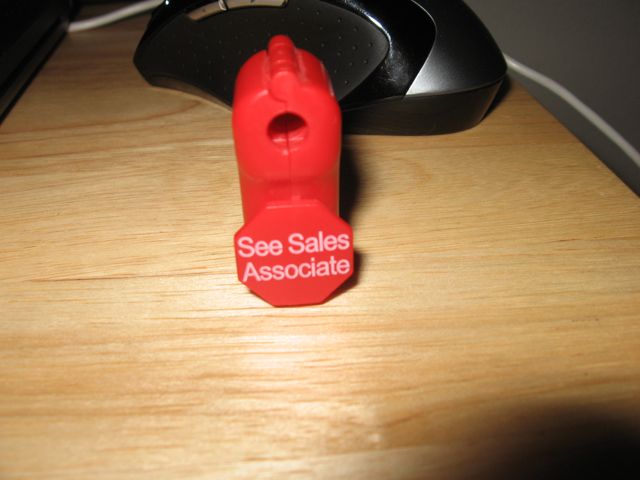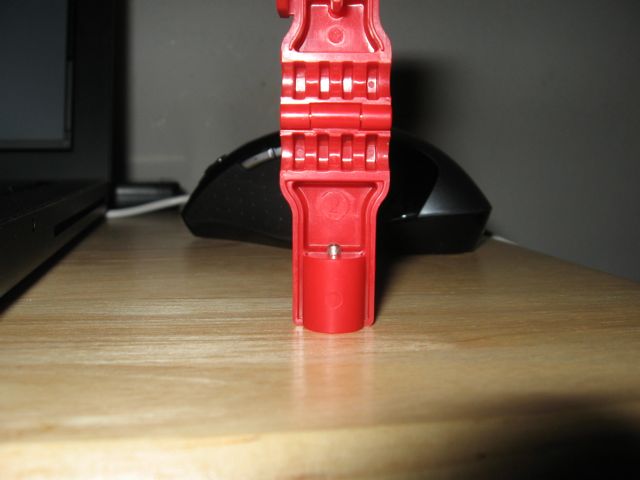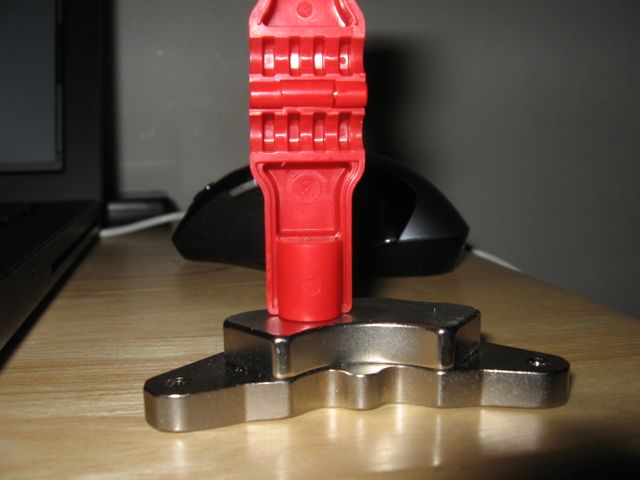 A great many of the popular merchandise security locks and tags operate simply on magnets. Those big plastic sticks you see hanging off of clothing? Usually unlocked at the register with a powerful magnet. The plastic locks that Blockbuster slides into the DVD cases on the display floor to keep people from opening them up until they've paid? Also opened with powerful magnets. The plastic things that keep you from removing cheap-ass MP3 players from the display hooks at Wal-Mart or the pharmacy? Guess what? Yep. Magnetic. Some use other means, like a set of plastic pins that unhook the latching mechanism. These days, RFID or inductor-loop systems physically sealed inside the packaging (or even inside the device!) are becoming more common, so this trick is fast becoming less relevant.
A great many of the popular merchandise security locks and tags operate simply on magnets. Those big plastic sticks you see hanging off of clothing? Usually unlocked at the register with a powerful magnet. The plastic locks that Blockbuster slides into the DVD cases on the display floor to keep people from opening them up until they've paid? Also opened with powerful magnets. The plastic things that keep you from removing cheap-ass MP3 players from the display hooks at Wal-Mart or the pharmacy? Guess what? Yep. Magnetic. Some use other means, like a set of plastic pins that unhook the latching mechanism. These days, RFID or inductor-loop systems physically sealed inside the packaging (or even inside the device!) are becoming more common, so this trick is fast becoming less relevant.
Shown above is a popular security device that simply clamps around a display hook, locking all of the products onto that hook until it's deactivated. Another common one you'll see is a big grey brick stuck on the end of the display hook. They both work the same way, though. When opened, you can see that a spring-loaded metal pin sticks out. This pin locks the other half shut, clasping this device firmly around the display hook. The display hook will either have a bend in it, or a thicker, rounded ball on the end -- usually both. This is sufficient to keep this plastic lock from being pulled off the end of the display hook. Now, a would-be shoplifter could probably pull the display hook out of the display board pretty easily, but then they would need to sneak out of the pharmacy with a whole batch of $9.99 Coby MP3 players. That's a lot more difficult to hide than just one.
When opened, you can see that a spring-loaded metal pin sticks out. This pin locks the other half shut, clasping this device firmly around the display hook. The display hook will either have a bend in it, or a thicker, rounded ball on the end -- usually both. This is sufficient to keep this plastic lock from being pulled off the end of the display hook. Now, a would-be shoplifter could probably pull the display hook out of the display board pretty easily, but then they would need to sneak out of the pharmacy with a whole batch of $9.99 Coby MP3 players. That's a lot more difficult to hide than just one. Your run-of the mill fridge magnet won't work, but the rare-earth magnets found in hard drives work wonders. A strong magnet will grab the spring-loaded pin and pull it out of the way, allowing the clasp to open.
Your run-of the mill fridge magnet won't work, but the rare-earth magnets found in hard drives work wonders. A strong magnet will grab the spring-loaded pin and pull it out of the way, allowing the clasp to open.
Other security devices, for example Blockbuster DVD locks, use two or more spring-loaded metal actuators. Behind the counter, the unlocking device has magnets already spaced apart just right to open them up. These systems are a little more secure.
So next time you see some kid messing around with rare earth magnets in the electronics aisle, know that it's probably not so he can corrupt hard drives or make pretty gauss patterns on CRT displays.
2008-02-16
Bypassing merchandise display locks
Posted by
Ax0n
Labels: hack, lockpicking, locks, physicalsecurity
blog comments powered by Disqus
Subscribe to:
Post Comments (Atom)




